
Around the Bloc: Poison Letters Put Czech Police on Alert, Russian Loan for French Nationalists
Plus, Georgia and her allies decry Russia-Abkhazia pact; Estonia opens its e-government platform to the world.
More...We kindly inform you that, as long as the subject affiliation of our 300.000+ articles is in progress, you might get unsufficient or no results on your third level or second level search. In this case, please broaden your search criteria.

Plus, Georgia and her allies decry Russia-Abkhazia pact; Estonia opens its e-government platform to the world.
More...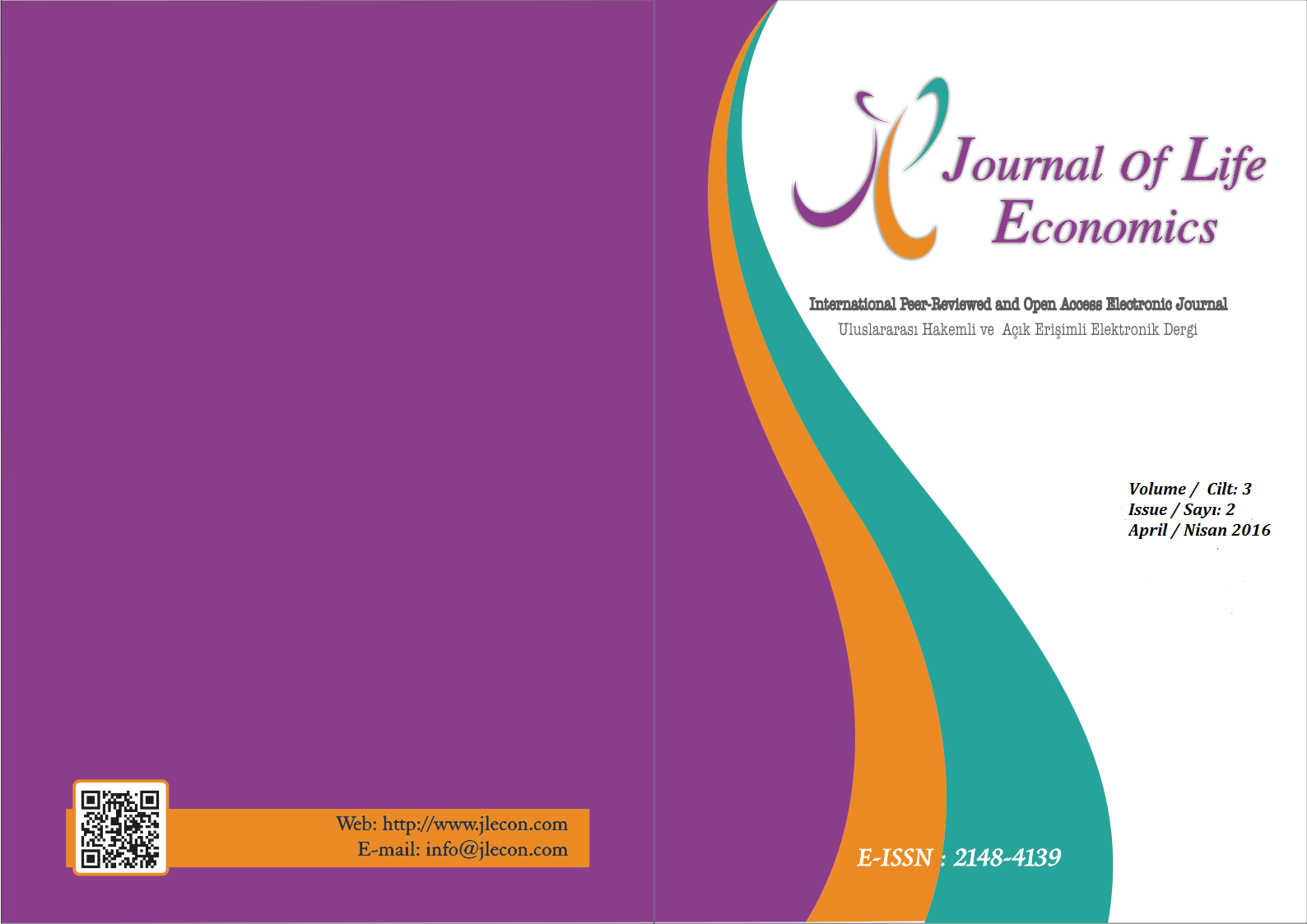
Parallel to the development of new communication environments with the help of technology in recent years, social media is defined as a virtual platform on which users share their knowledge and experiences. As consumers spend more and more time indoors, whether it is at work or at home, the use of social media increases and these consumers develop a good knowledge about products and services through advertisement. The objective of this research is to examine the relationship between online advertising, purchasing intention and word of mouth marketing. The research is exploratory and descriptive in nature. The data were generated cross sectionally. The questionnaires were conducted to 233 facebook users determined by convenience sampling method. The scales used for this research was developed and tested by other researchers. The data was analysed by using SPSS and NCSS 2007. The reliability of the data was found appropriate. Factor analysis, canonical correlation analysis and multiple regression analysis were used to analyse the data. As a result, it was found that the online advertisements has an effect on purchasing intention and word of mouth marketing.
More...
Electronics was born along with the 20th century. Its precursors in communications, telegraphy and telephony, were applications of electrotechnical engineering, which only became electronical after the discovery and adoption of electromagnetic waves as a carrier of information, and particularly after the invention of amplifying vacuum tubes.First communications in Romania via electromagnetic waves were achieved in 1901, virtually at the same time with the accomplishments of Marconi and Popov. The lack of a tradition in electrotechnics, as well as limited resources, caused the evolution of electronics in our country to progress at a different pace, and sometimes with different priorities, than worldwide.This paper aims to succinctly present this evolution for the widely recognized domains of Telecommunications, Professional Electronics, Computer Engineering, Components.While subtitled "milestones", the paper is rather ample, and was therefore split into three sections: - first section refers to the first semicentennial of Romanian electronics, where the four domains are largely commingled, similarly somewhat to the worldwide evolution back then; - second section covers the second half-century of Romanian electronics in Telecommunications; - third section follows the evolution of Professional Electronics, Computer Engineering and Components during the same period.
More...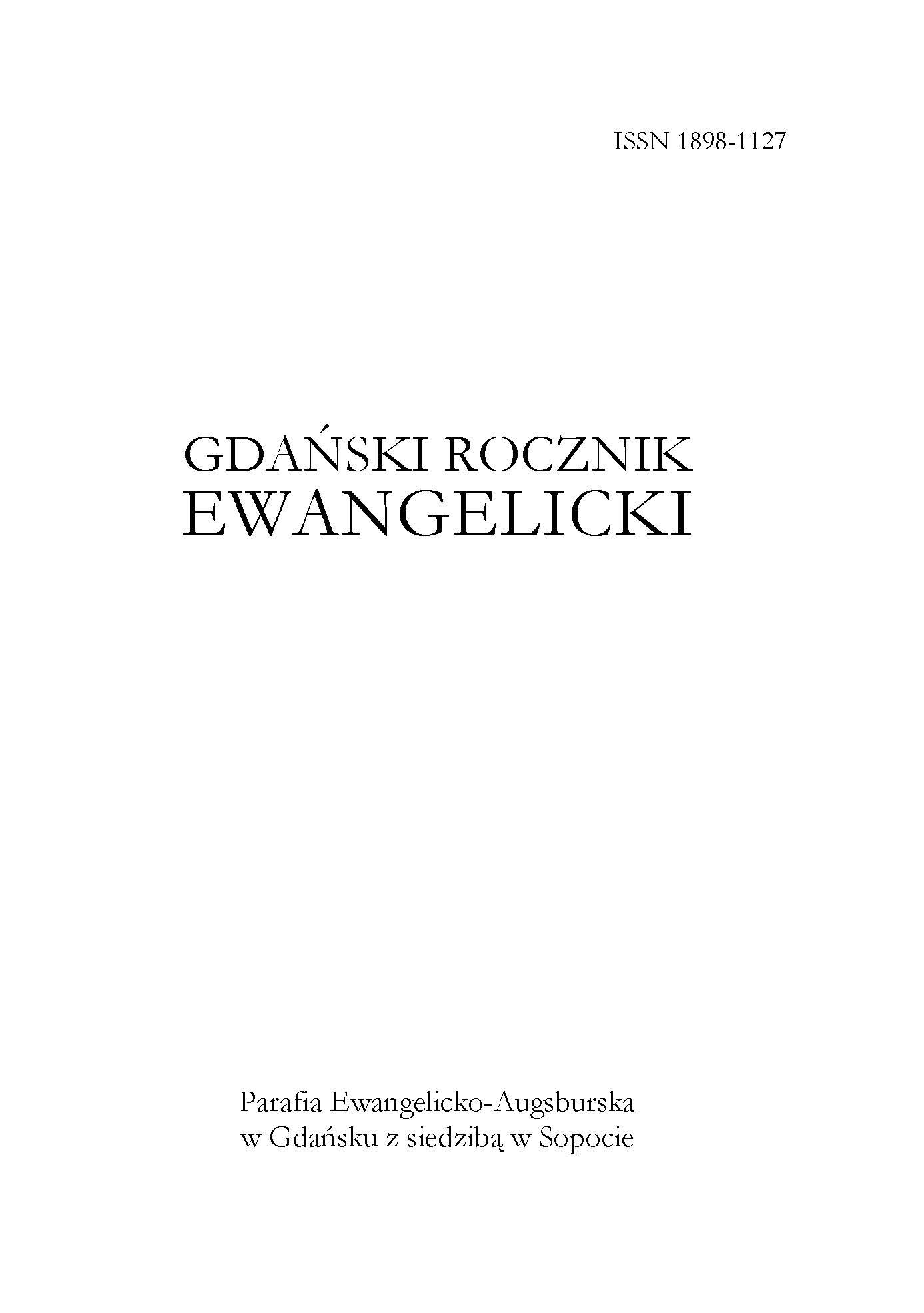
The essay is dedicated to the influence of the Protestantism on economic effectiveness. According to the well-known Max Weber’s thesis the Christian culture was of crucial significance for the incremental creation of the market economy principles. In turn the Protestantism formed fundamental background for „modern rational capitalism”. Richard Swedberg, famous economic sociologist, following Max Weber, pointed out three factors bound up with Protestantism that had an impact on modern capitalism. Firstly, Dr Martin Luther stressed that the calling of man is the everyday solid work. Secondly, Jean Calvin defined economic success as the proof of the grace of Lord. Thirdly, American Protestantism demands absolute obedience to the commandments and honest behaviour towards other people. The diligence, activity and honesty were the source of trust among people (today defined as a component of „social capital”). The main thesis of the essay focused on the role of Protestant inspiration in forming trust as the source of contemporary economic effectiveness. Sociological research (among others conducted by Ronald Inglehard) proved that relatively high level of trust (especially „bridging social capital”) is a vital feature of highly developed economies of the Protestant countries. However, it should be stressed that there exists no simple cause-effect relationship between these two phenomena. Rather, they are aspects of a complex correlation network.
More...
Azebaijan, which has been linked with oil for centuries, became a famous frontrunner in the world's oil indutry in the 19th century. Well before the famous discovery of oil in a drilled well in Pennsylvania bu Erwin Drake in 1859, Azerbaijan had drilled its first oil well in Bibi-Heybat (settlement of Baku) in 1846. And also, in 1851 at the World Exhibition in London, samples of oil from Baku (Absheron) oil fields were exhibited by Prince Mikhail Vorontsov (Viceroy of the Russian Emperor in Caucasus). Historical sources and documents found in recent years in the Central State Historical Archives of Russia and Azerbaijan prove that drilling of industrial oil wells began in Bibi-Heybat in 1846.
More...
In the middle of 1980s the development program of the romanian aeronautical industry was in full swing. It relied on collaboration with strangers partners, but also on the development some of the original products. The production was for both internal and exportal market. The investments made by the state were very high because this industry was considered very important for the country development. In that moment it were produced gliders, school,transport and fight aircrafts, ligh and medium helicopters, classic and reactions engines. The program perspective supposed the creation of a model of supersonic combat aircraft, an anti-tank helicopter model and the expansion of production on ROMBAC aircrafts.
More...
Like the other three volumes in the seriesdedicated to the Romanian electronics, this new volume deals with the history of research, design, production and operation of electronic equipment in Romania. Written by a team of over 50 authors, it has a pronounced memorialistic character. On the other hand, the issues are as concrete as possible, based on accurate information. The five chapters dealing with five areas represented by the institutions from the above domains are complemented by information about the authors, a rich bibliography, and numerous papers in electronic photocopies.
More...
This is the review of the new volume entitled Ingineri români: dicíonar enciclopedic, vol. II (Romanian Engineers: Encyclopedic Dictionary, vol. II), from a series initiated by Academician Gleb Dragan, and coordinated by the Section of Technical Sciences eithin the Romanian Academy. A new group of 265 personalities complete the original list.
More...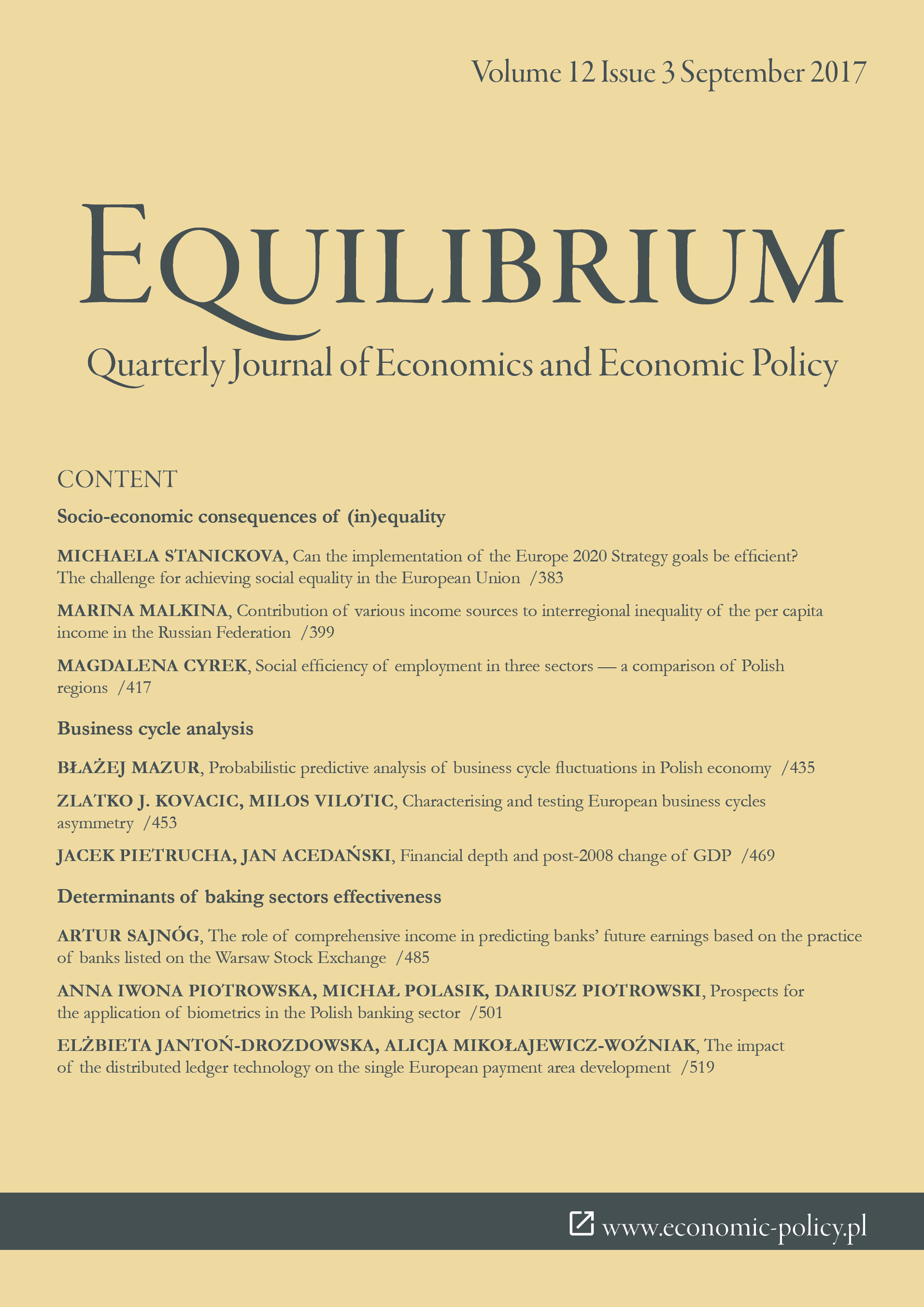
This paper researches the relationship between financial depth (private credit to GDP ratio) and the subsequent response of GDP to the 2007+ financial crisis. The prevailing view in the finance-volatility of growth nexus literature is that financial depth reduces production volatility, but this holds true only up to a certain level of financial depth. Another stream of research documents that rapid growth in credit is a financial crisis predictor. Purpose of the article: We ask: did financial depth or its change have any impact on the post-crisis response of the real sector? Methods: Cross-sectional regression, 144 countries. Findings & Value added: The post-crisis GDP response corresponds to a change of financial depth prior to the crisis, rather than to the financial depth itself. The increase of financial depth prior to the crisis is statistically significant to the extent of GDP drop; in countries where the credit-to-GDP ratio surged prior to the crisis, the post-crisis response of the real sector was more pronounced. There is no evidence that financial depth negatively affected the extent of the GDP drop after the 2007+ financial crisis; some calculations suggest that the effect is slightly positive (i.e. the collapse was less severe in the countries with higher financial depth). The variables relating to financial depth affected the response of GDP mainly in countries where financial depth is relatively high.
More...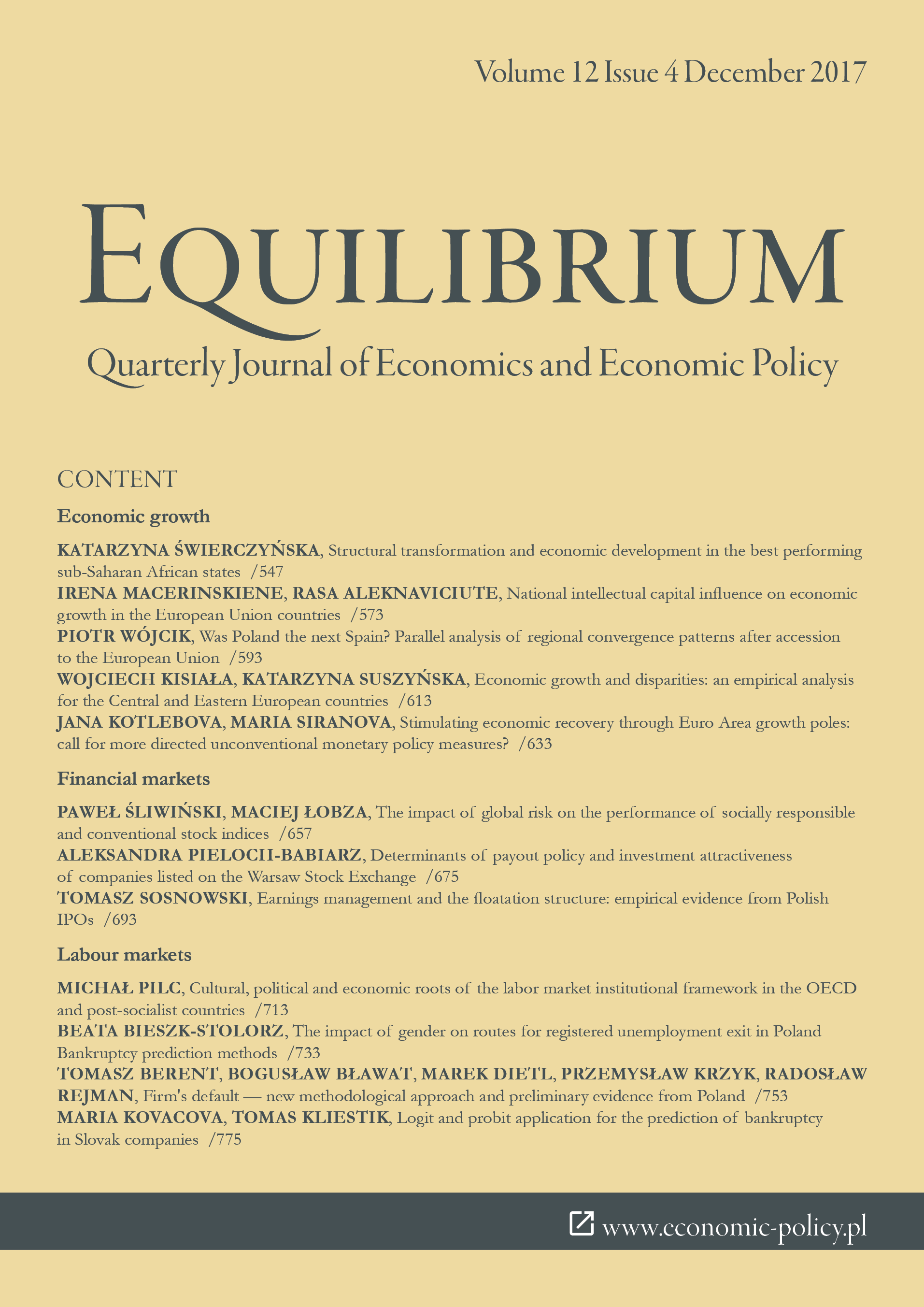
Economic development in sub-Saharan Africa is of paramount importance, yet it escapes most of the attempts to understand it better in the economic discourse, and it remains a sensitive issue in politics, contradicting stakeholders at national and international levels. The region still lags behind others in terms of technological advancement and economic development. It has grown significantly in the precedent decade, but the extent of growth has not sufficiently translated to its development. Determining strategies for sub-Saharan Africa is a scientific challenge, which requires more attention. In the globalized, interconnected reality, solving problems of the South is in the best interest of the North. Purpose of the article: The aim of this research is to analyze structural changes as factors of economic development in the best performing sub-Saharan African countries on the grounds of new structural economics in order to provide policy implications. Methods: Namibia, Botswana, South Africa and Gabon were selected as best performing economies in the region. Based on the literature review and the analysis of descriptive statistics, profiles of sample countries were set. This in turn allowed to determine the potential explanatory variables for OLS model of economic development. In the model, factors relating to labour productivity, technology and structural change were included. The data was sourced from WDI (World Development Indicators) database, Gretl software was used for computations. Findings & Value added: This paper contributes to the literature by attempting to explain structural changes in the process of economic development in the sub-Saharan region on the sample of best performing states. Results of the study revealed that there is no common way of economic development in sub-Saharan Africa. However, best performing states are characterized by relative advantage in human capital. Based on the results, policy implications were proposed with respect to technology promotion, natural resources management, and quality of institutions. The research was limited by data availability and reliability.
More...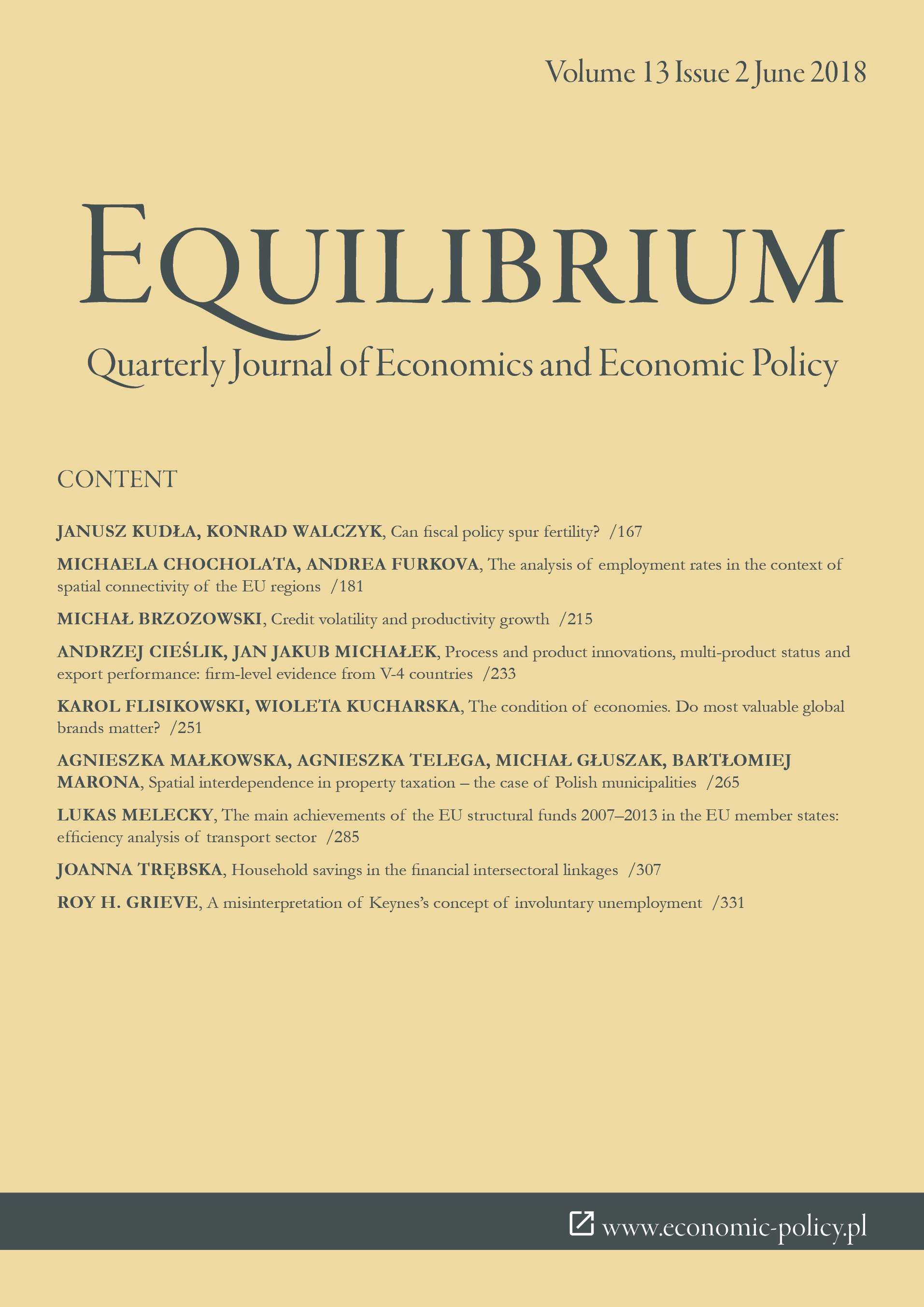
Brands are considered to be the most valuable asset of a company. Some of them achieve spectacular global results. The significance of global brands is proved by the fact that their value is often greater than the sum of all company’s net assets. Purpose of the article: The aim of this article is to highlight that brand value does not only create company’s value, but also leverages economies. The Authors claim that even though global brands are sold worldwide and are a part of “global factories”, they strongly relate to the development of economies in the countries where these brands’ headquarters are located. Methods: Based on 500 Brandirectory, the Most Valuable Global Brands ranking powered by Brand Finance, an analysis of spatial auto correlation of brand values, GDP per capita was performed and also the interdependency between them was illustrated with the use of the spatial cross-regressive model (SCM). The SCM approach allowed us to include spatial effects of brand values into the final form of the estimated equation. The empirical analysis was performed for 33 countries in 2014. Findings & Value added: Findings confirm the hypothesis that there is a highly statistically significant relationship between brand value and GDP per capita and, what’s more, it is observed that spatial dependencies matter for brand values. The evidence is based on the results of spatial cross-regressive model (SCM).
More...
Real estate and urban economics literature are abundant in studies discussing various types of property taxes and their characteristics. A growing area of research has been focused on tax equity, tax competition, and yardstick competition, where the latter two reflect the idea of tax mimicking. Recently, due to substantial developments in spatial and regional economics, more attention has been drawn to spatial effects. Empirical results are focused on spatial interaction and diffusion effects, hierarchies of place and spatial spillovers. Property tax system in Poland differs from those utilized in the majority of developed countries. As a consequence, property tax policy at the local government level (including tax competition and tax mimicking effects) in Poland can differ substantially from those found in previous research in the US and other European countries. There are few studies addressing the problem of tax competition and tax mimicking in Poland from an empirical perspective. Purpose of the article: In the article, we explore spatial interdependence in property taxation. We identify clustering or dispersion of high and low values of the tax rates within major metropolitan areas in Poland. The effects can indicate the presence of tax mimicking among municipalities in given metropolitan areas. Methods: We analyze the data from 304 municipalities in 10 metropolitan areas in Poland from the year 2007 to 2016. The data covers four property tax rates: (1) on residential buildings (2) on buildings used for business purpose (3) on land used for business purpose (4) on land for other uses. To explore the spatial distribution of rates, we used global and local spatial autocorrelation indicators (Moran’s I statistic and LISA). Findings & Value added: The results suggest the presence of spatial correlation within metropolitan areas. We also found significant differences between metropolitan areas. The results of the study fill the gap in empirical research concerning property tax interdependencies and tax mimicking in Poland.
More...
Savings of households are accumulated as a result of individual propensity to save. Simultaneously, they provide the sources of financing investments in the economy through financial institutions as intermediaries in the flow of funds, between entities with a surplus and those with a demand for them. Purpose of the article: The paper aims at indicating the changes in the structure of households’ financial savings in Poland in the period 2003–2015, as well as at exploring them as a source of financing the activities of other sectors through institutional mechanisms of the financial system. Methods: Intersectoral financial flows were estimated using input-output methods for compiling “sector by instrument” tables of financial assets and liabilities into “sector by sector” matrices of intersectoral flows of each financial instrument. The research is based on statistical data published in the Eurostat database, i.e. annual accounts — financial balance sheets by institutional sectors and subsectors. The role of households’ financial savings in the network of intersectoral linkages in the financial system has been examined on the basis of financial input-output model. Findings & Value added: The comparison of the significance of particular institutional sectors’ supply of funds clearly indicates that the increase in households’ financial assets causes the largest increase in financial flows both as a result of direct effect and indirect effects reflecting the size of these flows’ feedback in the financial system. The study presented herein is the first application of the input-output approach for the Polish financial system. The idea of financial input-output model proposed by Tsujimura & Mizoshita (2003) is extended to disaggregate intersectoral flows in the form of individual financial instruments.
More...
The European Union currently provides financial support to the Member States through various financial tools from European Structural and Investment Funds 2014–2020, and previously from the EU Structural Funds. In both terminologies, the funds represent the main instrument of EU Cohesion Policy to sustain territorial development, to increase competitiveness and to eliminate regional disparities. The overall impact of EU Funds depends on the structure of funding and absorption capacity of the country. Purpose of the article: The efficiency of funding across the EU Member States is a fundamental issue for EU development as a whole. The Author considers deter-mining the efficiency of EU Funds as an issue of high importance, and therefore this paper provides a contribution to the debate on the role of EU Cohesion Policy in the Member States. The paper focuses on territorial effects of relevant EU Funds in programming period 2007–2013 in infrastructure through efficiency analysis. Methods: Efficiency analysis is based on data at the country level, originating from ex-post evaluation of Cohesion Policy programs 2007–2013 and representing the input and output variables to analyse whether the goal of fostering growth in the target countries have been achieved with the funds provided, and whether or not more resources generated stronger growth effects in transport accessibility. The paper deals with comparative cross-country analysis, descriptive analysis of data set and multiple-criteria approach of Data Envelopment Analysis (DEA) in the form of output-oriented BCC VRS model of efficiency and output oriented APM VRS subsequently model of super-efficiency. Findings & Value added: The paper aims to test the factors of two inputs and five outputs, trying to elucidate the differences obtained by the Member States in effective use of the European Regional Development Fund and the Cohesion Fund in the transport sector. The paper determines if the countries have been more efficient in increasing their levels of competitive advantages linked with transport. Preliminary results reveal that most countries with a lower amount of funding achieve higher efficiency, especially countries in a group of so called “old EU Member States”, i.e. group EU15.
More...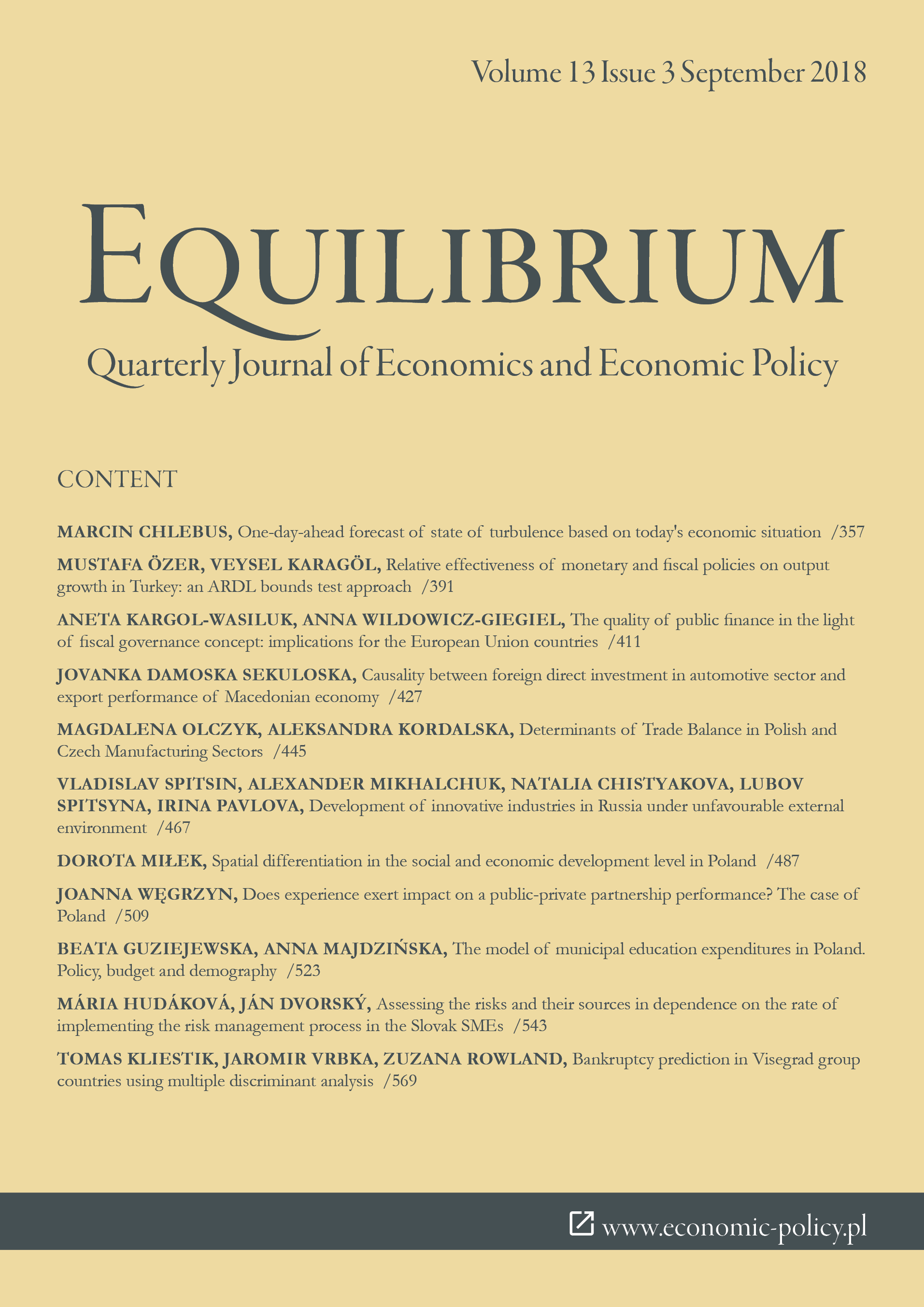
In the literature little discussion was made about predicting state of time series in daily manner. The ability to recognize the state of a time series gives, for example, an opportunity to measure the level of risk in a state of tranquility and a state of turbulence independently, which can provide more accurate measurements of the market risk in a financial institution. Purpose of the article: The aim of article is to find an appropriate tools to predict, based on today's economic situation, the state, in which time series of financial data will be tomorrow. Methods: This paper proposes an approach to predict states (states of tranquility and turbulence) for a current portfolio in a one-day horizon. The prediction is made using 3 different models for a binary variable (Logit, Probit, Cloglog), 4 definitions of a dependent variable (1%, 5%, 10%, 20% of worst realization of returns), 3 sets of independent variables (untransformed data, PCA analysis and factor analysis). Additionally, an optimal cut-off point analysis is performed. The evaluation of the models was based on the LR test, HosmerLemeshow test, Gini coefficient analysis and CROC criterion based on the ROC curve. The analyses were performed for 43 individual shares and 5 portfolios of shares quoted on the Warsaw Stock Exchange. The study has been conducted for the period from 1 January 2006 to 31 January 2012. Findings & Value added: Six combinations of assumptions have been chosen as appropriate (any model for a binary variable, the dependent variable defined as 5% or 10% of worst realization of returns, untransformed data, 5% or 10% cut-off point respectively). Models built on these assumptions meet all the formal requirements and have a high predictive and discriminant ability to one-day-ahead forecast of state of turbulence based on today's economic situation.
More...
Effects of monetary and fiscal policy on output growth has been one of the major topics that economists have been investigating. Monetary and fiscal policies are tools for economists and policymakers to correctly direct the economy and facilitate the growth and development of the country. Accordingly, it is critically important for policy-makers in the area of economy to study the efficiency and the effectiveness of such policies. But, so far, there has been no generally accepted evidence suggesting the effectiveness of either the policy in Turkey or around the world. Instead, the dominance of either policy is subject to a change period to period and country to country. Purpose of the article: The purpose of this study is to analyze the growth effectiveness of fiscal and monetary policies and then determine which of these two policies is more powerful in promoting economic growth in Turkey over the period 1998 and 2016. Methods: To investigate the growth effectiveness of monetary and fiscal policies, we use some of the time series econometric techniques, such as ARDL Bounds testing, structural break unit root tests and Granger causality tests. Findings & Value added: Monetary policy variable is creating only short-run effects on growth; but, it’s not causing any Granger causality on it. On the other hand, fiscal policy variable has a long-run significant effect and causing to growth. Thus, the fiscal policy seems to be more effective than monetary policy during examination period, implying the rethinking the implementation of both policies in Turkey. To the best of our knowledge, this study is the first attempt to investigate the relative effectiveness of economic policies on growth in Turkey in terms of both methods used and period chosen.
More...
The research area on the quality of public finance (QPF) appears to be intellectually attractive. In the light of the challenges of the 21st century, public finance should be characterized by adequate quality, ensuring effective implementation of the economic functions of government. The problem of QPF is increasingly more frequent in the face of a deteriorating fiscal situation of most countries in Europe and around the world. Hence, it is worth considering which factors determine the quality of public finance. Purpose of the article: This article aims to show the possibility of assessing the quality of public finance in the light of fiscal governance concept. The identification of the key components of QPF seems to be useful from the point of view of empirical research, and can be implemented to assess the quality of public finance in the EU–28. Methods: Descriptive analysis along with principal component analysis (PCA) was implemented to indicate dimensions of QPF. Findings & Value added: The quality of public finance consists of a well-designed fiscal rules (numerical and non-numerical) and institutions, as well as structural reforms. The obtained results allow to characterize the quality of public finance through the prism of six identified principal components. They have a mixed character, two of them are partly or totally related to the institutional aspects of public finance, which proves their importance in the process of improving the quality of public finance. Improving the quality of public finance remains a key challenge for policy makers in the EU. The growing impact of globalization and the aging population also cause the need to improve the qualitative aspects of fiscal policy. The study contributes to the literature on public finance, particularly in the empirical dimension through broadening the knowledge on institutional factors which can be used to measure QPF index. The results of research have certainly enriched the existing knowledge on the phenomenon of QPF and the ways of its measurement.
More...
Social and economic development involves a broad spectrum of social, economic and spatial phenomena. The multi-faceted nature of regional development arises directly from the fact that it is shaped by multiple factors. Current discourse emphasizes the role of endogenous factors, which indicate the specific nature and the distinctive features of the given territory. Mobilizing the endogenous potential ensures stable regional development dynamics. At the moment, one of the fundamental economic problems are the increasing differences in the development of specific regions. Purpose of the article: The purpose of this study is to assess the differentiation of the social and economic level development of Polish Voivodeships, applying the selected assessment methods for the years 2010 and 2015, draw up a rank list of regional units according to their development levels, and identify the groups of Voivodeships sharing similar development levels. The indicators used in this study, characterizing the level of the social and economic development, have been systematized according to the following areas: demographics and labor market, regional entrepreneurship, local economy structure, innovation and research & development activities, technical infrastructure, social infrastructure, and the condition and protection of the natural environment. Methods: The level of the social and economic development of Polish Voivodeships was assessed using Zdzisław Hellwig’s development pattern method, which made it possible to rank them according to the level of development of Polish Voivodeship. The methodology is supplemented by Ward’s agglomerative clustering method, which made it possible to distinguish other Voivodeships according to the analysed phenomenon. The Voivodeship clustering method used Jenks' natural breaks classification method. Findings & Value added: Pursuing the research aims, the authors focused in particular on clear spatial differences. Through the analysis we were able to identify the changes in the social and economic development processes of the Polish regions. The Voivodeships were divided into groups according to their development level: the highest, high, low and the lowest.
More...
Municipal education expenditures finance the delivery of one of the key public services devolved by central government to lower levels of government. Traditional studies in this field are divided based on whether they consider socio-economic determinants or political factors within the new political economy. The study presented herein was undertaken to explore the role of demo-graphic factors which are frequently ignored in research. Purpose of the article: This study seeks to identify which variables statistically significantly influence the level of education expenditures in municipalities. The empirical investigation is based on a sample of 2478 Polish municipalities and uses the 2016 Central Statistical Office data to analyse the correlations and regressions between municipal education expenditures and selected economic and socio-demographic factors. Methods: The parameters of the power and exponential model are estimated using the Generalised Least Squares Method. Findings & Value added: The results of the statistical analysis have shown a moderate, positive and significant correlation between municipalities’ own revenue per capita and local share of education funding per capita. According to the regression analysis results, the model’s explanatory variables accounted for 61% of the variance in municipal education expenditures per capita. The added value of the study is that it highlights the educational challenges related to the demographic situation in Poland that public authorities will soon have to address.
More...
The problem of bankruptcy prediction models has been a current issue for decades, especially in the era of strong competition in markets and a constantly growing number of crises. If a company wants to prosper and compete successfully in a market environment, it should carry out a regular financial analysis of its activities, evaluate successes and failures, and use the results to make strategic decisions about the future development of the business. Purpose of the article: The main aim of the paper is to develop a model to reveal the unhealthy development of the enterprises in V4 countries, which is done by the multiple discriminant analysis. Methods: To conduct the research, we use the Amadeus database providing necessary financial and statistical data of almost 450,000 enterprises, covering the year 2015 and 2016, operating in the countries of the Visegrad group. Realizing the multiple discriminant analysis, the most significant predictor and the best discriminant of the corporate prosperity are identified, as well as the prediction models for both individual V4 countries and complex Visegrad model. Findings & Value added: The results of the research reveal that the prediction models use the combination of same financial ratios to predict the future financial development of a company. However, the most significant predictors are current assets to current liabilities ratio, net income to total assets ratio, ratio of non-current liabilities and current liabilities to total assets, cash and cash equivalents to total assets ratio and return of equity. All developed models have more than 80% classification ability, which indicates that models are formed in accordance with the economic and financial situation of the V4 countries. The research results are important for companies themselves, but also for their business partners, suppliers and creditors to eliminate financial and other corporate risks related to the unhealthy or unfavorable financial situation of the company.
More...